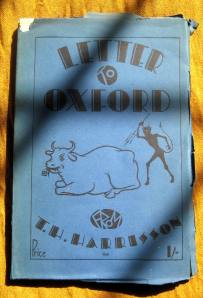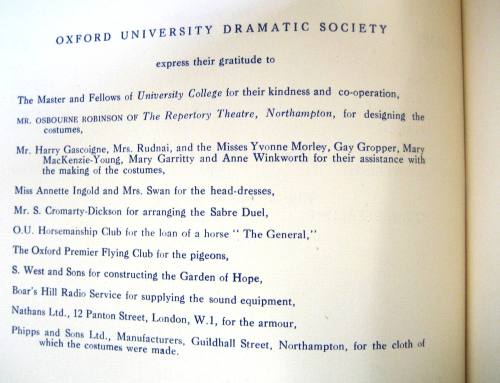Erich Alport was an Oxford fresher in 1926. He arrived at Univ as an international student from Germany.
Oxford, in those days, was still a city of aquatint…her autumnal mists, her grey springtime, and the rare glory of her summer days…exhaled the soft vapours of a thousand years of learning. – Charles Ryder (Brideshead Revisited, Evelyn Waugh, 1945)
Zuleika Dobson
Before his journey to Oxford, Alport was given a copy of Max Beerbohm’s novel Zuleika Dobson, a fantastic distillation of Beerbohm’s time at Merton College in the 1890s. Fr. Hanepen or R. Hanepon (the unidentifiable giver with an illegible signature) may have wanted to give an aspiring student an idea of the University he was joining. It would have been a strange one
In Beerbohm’s only novel, Zuleika, the supernaturally attractive heroine pays a fatal visit to an Oxford where the University’s undergraduates drown themselves en masse in the Thames for unrequited love of her. The novel opens at Oxford station where Zuleika’s grandfather, the Warden of Judas College, welcomes her to Oxford. As they proceed by carriage to his College they pass the “high, grim busts of Roman Emperors” outside the Sheldonian Theatre. The stones sense the impending tragedy.
A moment later, a certain old don emerged from Blackwell’s, where he had been buying books. Looking across the road, he saw to his amazement great beads of perspiration glistening on the brows of these Emperors. – Max Beerbohm (Zuleika Dobson, 1911)
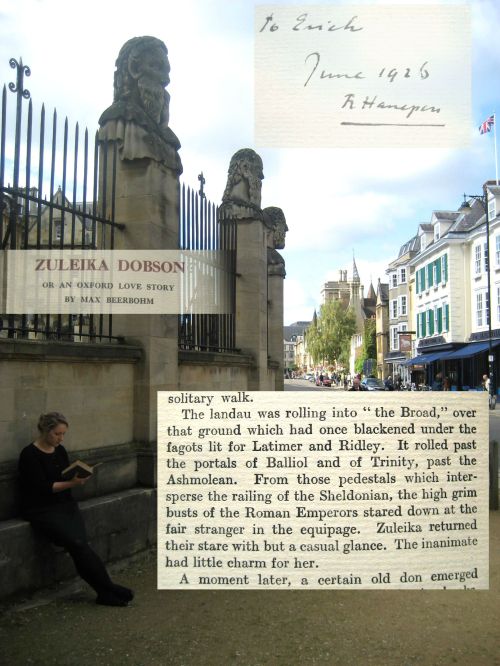
Verity, Univ’s Academic Officer, reads “Zuleika Dobson” on Broad Street; inscription in Alport’s copy; part of title page; excerpt from Alport’s copy (note that the Ashmolean referred to in the passage was housed in the building that is now the Museum of the History of Science).
Whether or not Zuleika Dobson was good preparation for Alport’s first year at Oxford, Zuleika waltzed back into his life in 1952 when he was invited to the opening of The Randolph Hotel ballroom freshly painted with 12 scenes from the novel by the cartoonist Osbert Lancaster.
Brideshead Revisited
Alport did not fall foul of any real life femmes fatale, instead he met Stephen Spender who arrived at Univ in 1927 to read PPE. When Evelyn Waugh’s novel Brideshead Revisited was published in 1945, Alport may well have found resonance with Charles Ryder who meets the mesmerising Sebastian Flyte during his third term in Oxford. (Waugh was a near contemporary of Alport’s at Oxford, matriculating from Hertford College in 1922).
I was in search of love in those days, and I went full of curiosity and the faint, unrecognised apprehension that here, at last, I should find that low door in the wall, which others, I knew, had found before me, which opened on an enclosed and enchanted garden, which was somewhere, not overlooked by any window, in the heart of that grey city. – Charles Ryder (Brideshead Revisited, Evelyn Waugh, 1945)
Alport’s well-read copy of Brideshead Revisited has his name pencilled inside the front cover.
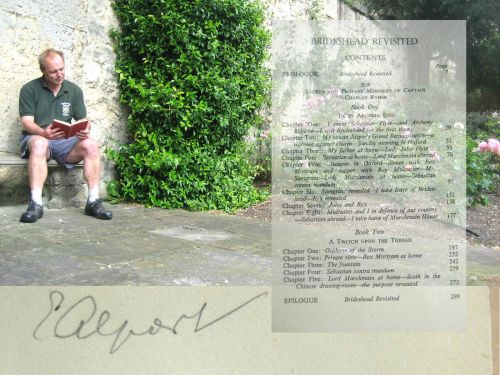
Bruce, Univ’s Head Gardener taking a short break from his work in the Master’s Garden to read Alport’s copy of Brideshead Revisited; Alport’s signature in his copy; the contents page of the novel.
Letter to Oxford
It is difficult to tell whether Alport read his copy of T.H. Harrison’s polemical, self-published, Letter to Oxford. He may have picked it up on the streets of Oxford where its author sold copies from a barrow (wearing sandals with his toenails painted red).
Cambridge University refugee and Oxford resident, Tom Harrison at 21 years old berated Oxford undergraduates for their lack of action and risk taking. This after the Oxford Union voted against the motion that the house would fight for king and country, twice. Harrison’s 1933 pamphlet accuses undergraduates of preferring masturbation to sex, indolence to activity and cowardly intolerance to full bloodied hatred.
It is unthinkable that these vile boys in Univ. should beat up Stephen Spender…But I am for intolerance. I am for beat ups. I am for good red hate. Put the miserable little man in the river. Put everyone in the river.– T. H. Harrison (Letter to Oxford, 1933)
Harrison would have approved of the actions of Zuleika Dobson’s admirers. After penning this damning piece of social observation, Harrison continued his career in an anthropological vein, founding the Mass Observation Project and gaining notoriety as The Barefoot Anthropologist.
The Masque of Hope
Univ appeared in a better light in Neville Coghill’s The Masque of Hope which was performed in Radcliffe Quad to H.R.H. Princess Elizabeth when she visited in 1948.

David, one of Univ’s Porters holds the Masque of Hope in Radcliffe Quad where it was first performed; Costume designs for Fear and Gloom; Dedication in Alport’s copy from the Author.
Hope and her children overcome Fear and its minions (including Gloom, Rumour and Black Market), in action that is strangely resonant with today’s popular concerns, particularly those about the economy. Notable among Hope’s children is Health; the NHS was founded the same year the masque was performed.
Though I’m their mother, do not be surprised
I took good care to have them nationalised.
– Hope (The Masque of Hope, Neville Coghill, 1948)
In Alport’s copy, an excited Coghill exclaims, “Wishing you could have seen it!” Perhaps it’s time for Univ Players to give The Masque of Hope a revival. It might be a tough job to source the pigeons though unless the Oxford Premier Flying Club still exists (see picture of acknowledgements from the programme above).
Welcome to Oxford!
The Alport Collection boasts other Oxoniana. Here are some of the most colourful:
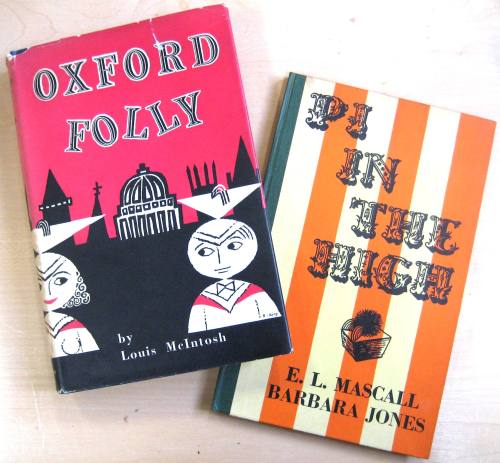
The library has reading copies of some of the novels mentioned:
Zuleika Dobson by Max Beerbohm (YIK/BEE)
Bridehead Revisited by Evelyn Waugh (YIO/WAU)
All images on this page are copyright of University College.

